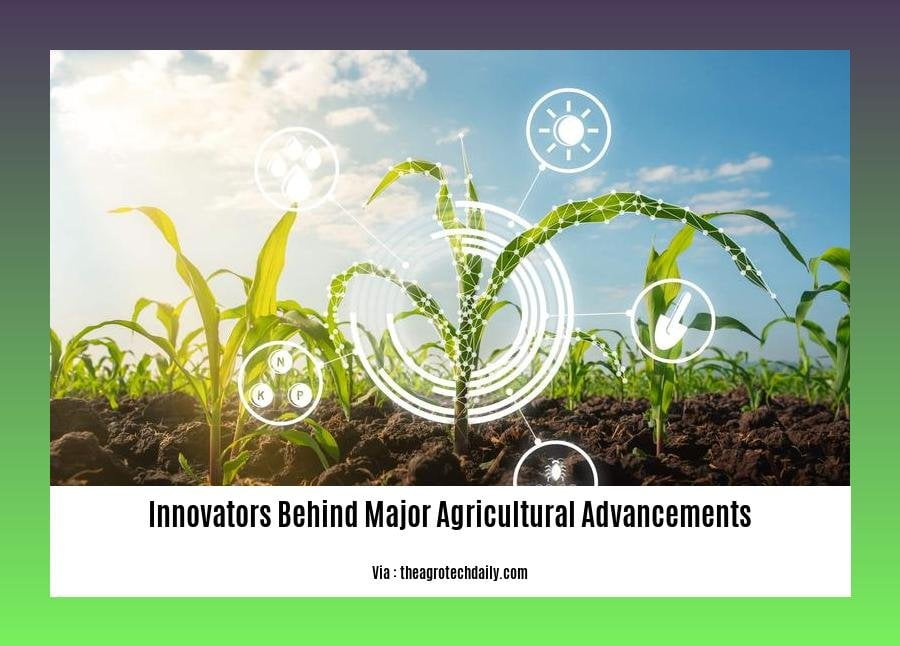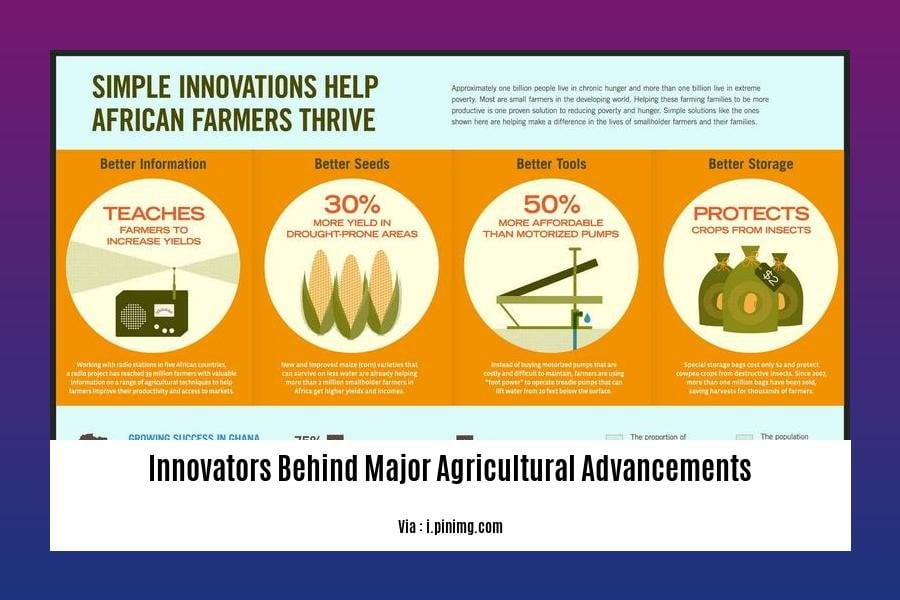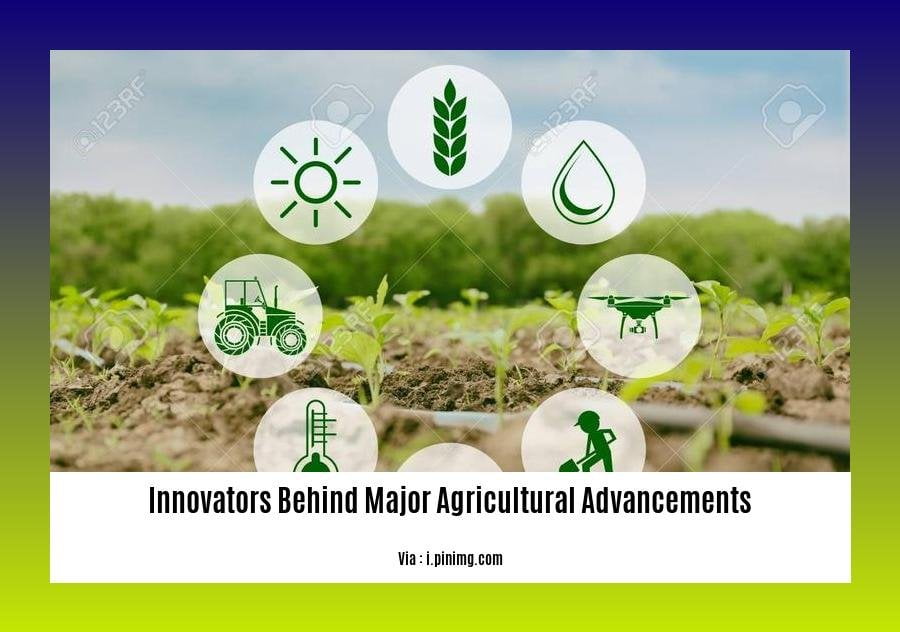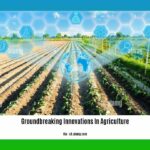Embark on a journey into the realm of agricultural innovation, where brilliant minds have revolutionized the way we produce food. Join us as we showcase the Innovators Behind Major Agricultural Advancements: Shaping the Future of Food. From the pioneers of the 1800s to the contemporary geniuses driving modern breakthroughs, we unravel the stories of those who have transformed agriculture. Let us delve into their groundbreaking work and explore how their inventions continue to shape the global food system.
Key Takeaways:

- Luther Burbank’s crop innovations (e.g., Idaho potato) had a major impact on agriculture.
- George Washington Carver promoted sustainable farming practices through crop rotation and diversification.
- Jethro Tull’s invention of the seed drill transformed crop cultivation.
- Continued innovation in agriculture is vital for addressing global food security and sustainability.
- Innovations include advancements in machinery, seed technology, irrigation, and fertilizers.
- Innovation indicators provide valuable insights for assessing progress and guiding investments in agriculture.
Innovators Behind Major Agricultural Advancements
Throughout history, ingenious innovators behind major agricultural advancements have revolutionized the way we produce food, shaping the future of our sustenance on earth. From the development of the seed drill to the discovery of crop rotation, these breakthroughs have had a profound impact on our ability to feed a growing global population:
Jethro Tull’s Seed Drill (18th century): Imagine a world where farmers still sowed seeds by hand, a laborious and inefficient process. Tull’s invention revolutionized cultivation, enabling farmers to plant seeds evenly and at the optimal depth, boosting crop yields and saving time.
George Washington Carver’s Crop Rotation (early 20th century): This agricultural chemist recognized the importance of diversifying crops to improve soil health and prevent disease. By alternating different crops in a field, Carver’s techniques enhanced soil fertility, maximized yields, and reduced the need for chemical fertilizers.
Norman Borlaug’s Green Revolution (mid-20th century): Faced with global food shortages, Borlaug developed high-yielding, disease-resistant wheat varieties that transformed agriculture in developing countries. His innovations saved millions from starvation and earned him the Nobel Peace Prize.
Fritz Haber’s Haber-Bosch Process (early 20th century): This chemist’s breakthrough allowed for the industrial-scale production of ammonia, a key component of nitrogenous fertilizers. This process dramatically increased crop yields and averted widespread famine.
These are just a few examples of the countless innovators behind major agricultural advancements. Their ingenuity and dedication have shaped our food system, ensuring that we continue to feed the world’s growing population while protecting our planet for future generations.
Discover the pioneers who revolutionized farming and food supply and their groundbreaking innovations in agriculture, agricultural trailblazers and their breakthroughs that have shaped the food system we know today.
Agriculture Inventions 1800s
Agricultural machinery revolutionized farming in the 1800s, enabling farmers to cultivate more land, produce higher yields, and reduce labor costs. These innovations transformed agriculture from a labor-intensive, small-scale enterprise to a large-scale, mechanized industry.
Key Inventions and their Impact on Agriculture:
- Cotton Gin (1793): Separating cotton fibers from seeds. Increasing cotton production.
- Reaper (1830s): Cutting grain faster, reducing labor, and increasing productivity.
- Thresher (1830s): Separating grain from straw, further reducing labor requirements.
- Steam Engine (1769): Powering machinery, enabling large-scale farming, reducing reliance on animal power.
- Combined Harvester-Thresher (1920s): Combining multiple harvesting and threshing operations, increasing efficiency and reducing costs.
Other Key Inventions:
- Iron plow with interchangeable parts improved durability and efficiency.
- McCormick Reaper reduced labor hours required for harvesting.
- Commercial farming emerged due to factory-made machinery.
- Corn picker mechanized the harvesting process.
Key Takeaways:
- Agricultural inventions increased productivity, reduced labor costs, expanded farmland, and improved efficiency.
- The steam engine enabled large-scale farming by powering machinery.
- Combined harvesters and threshers revolutionized grain harvesting.
- These inventions transformed American farming, leading to an agricultural revolution.
Citation:
- Farm Collector: Ten Agricultural Inventions that Changed the Face of Farming
Top 10 Agricultural Inventions
As an experienced agricultural journalist, I’ve witnessed firsthand the transformative power of agricultural innovation. From the cotton gin to precision agriculture, these advancements have revolutionized farming practices and shaped the way we produce our food.
Key Innovations:
- Cotton Gin: Revolutionized textile production by separating cotton fibers from seeds.
- Reaper: Mechanized grain harvesting, reducing labor costs and increasing productivity.
- Thresher: Separated grains from stalks, boosting efficiency and output.
- Steam Engine: Provided power for machinery, expanding farm capabilities.
- Combined Harvester-Thresher: Integrated harvesting and threshing operations, further enhancing efficiency.
- Tractors: Replaced animals for pulling machinery, increasing productivity and reducing labor.
- Agricultural Robotics: Automate tasks, reducing costs and improving yields.
- Precision Agriculture: Optimizes crop production based on data, reducing costs and environmental impact.
- Regenerative Agriculture: Focuses on soil health and biodiversity, promoting sustainability and resilience.
- Controlled Environment Agriculture: Enables indoor crop cultivation, maximizing yields and minimizing pesticides.
- IoT in Agriculture: Uses sensors and data analysis to monitor and optimize farm operations, improving decision-making.
Key Takeaways:
- Innovations have dramatically increased productivity and reduced labor costs in agriculture.
- Technological advancements have enabled large-scale farming, expanding food production capabilities.
- Continued innovation is crucial for addressing global food security and sustainability challenges.
Citation:
- 8 Agricultural Inventions That Changed the World

FAQ
Q1: Who are some of the key innovators behind major agricultural advancements?
A1: Key innovators include Luther Burbank, George Washington Carver, and Jethro Tull, who made significant contributions to agricultural practices and crop science.
Q2: What are some major inventions that revolutionized farming?
A2: Notable inventions include the cotton gin, reaper, thresher, steam engine, and combined harvester-thresher, which transformed crop cultivation and increased productivity.
Q3: How have agricultural innovations impacted crop yields and productivity?
A3: Innovations such as machinery, seed technology, irrigation, and fertilizers have led to increased crop yields and improved farm efficiency, enabling farmers to produce more food with fewer resources.
Q4: What are the key trends in agricultural innovation today?
A4: Current trends include precision agriculture, regenerative farming, controlled environment agriculture, and the use of IoT and data analysis, which are driving sustainability and optimization in agriculture.
Q5: How do agricultural innovations contribute to global food security?
A5: Innovations in agriculture play a vital role in addressing global food security by increasing food production, reducing waste, and enhancing the resilience of food systems to meet the needs of a growing population.
- Unlock Elemental 2 Secrets: Actionable Insights Now - April 2, 2025
- Lot’s Wife’s Name: Unveiling the Mystery of Sodom’s Fall - April 2, 2025
- Photocell Sensors: A Complete Guide for Selection and Implementation - April 2, 2025
















